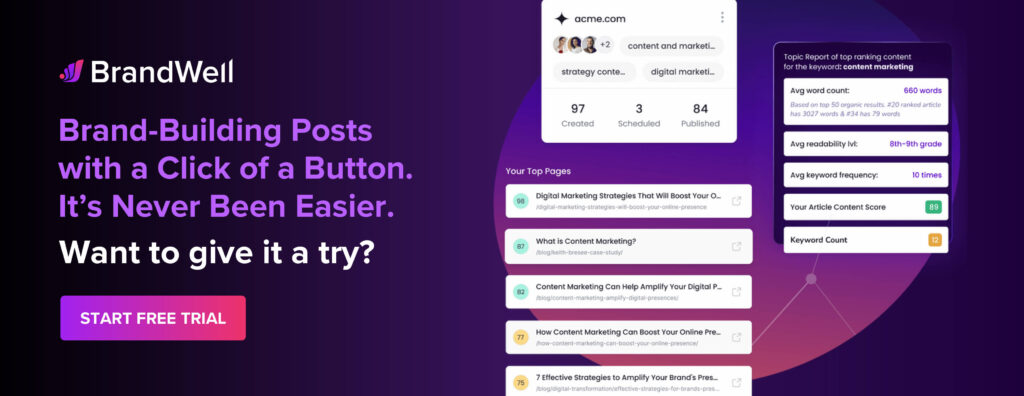Discover top guides, trends, tips and expertise from AIO Writers
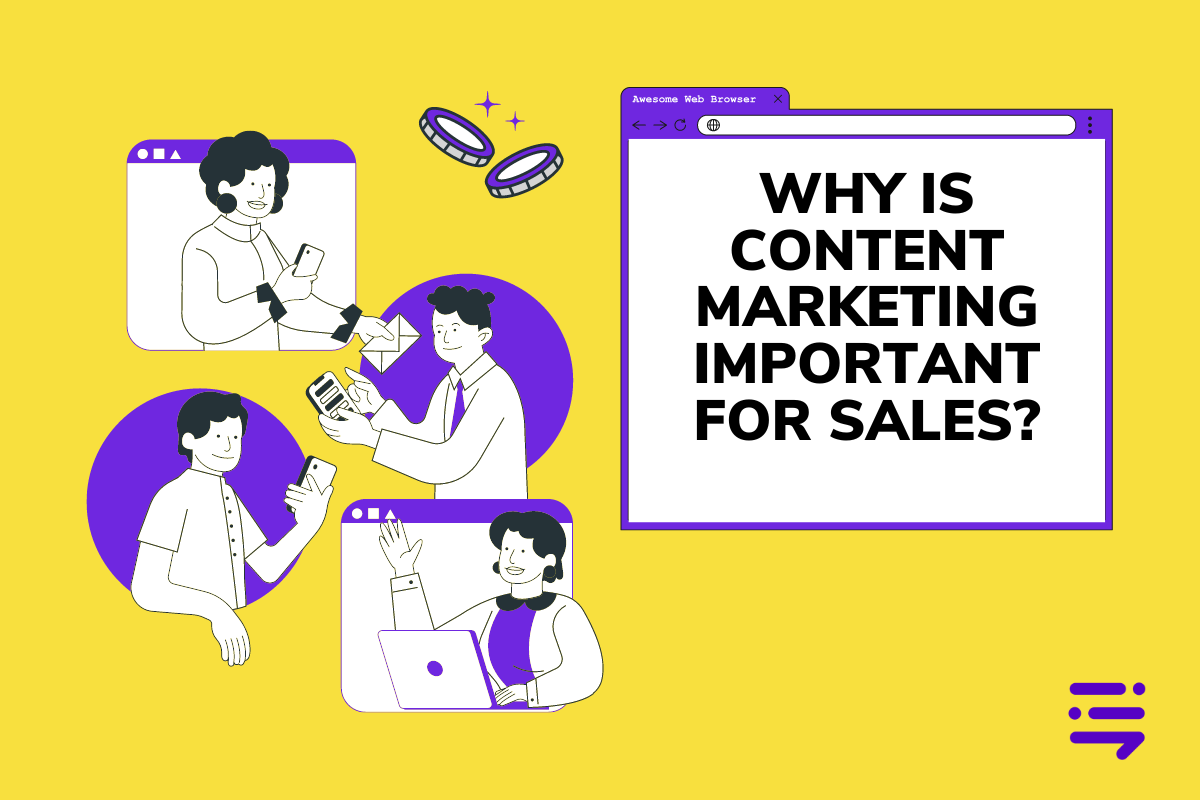
Content marketing, when done correctly, not only attracts leads but also increases sales.
Why is content marketing important for sales?
Because, unlike other lead generation strategies like cold calling or paid advertisements, content marketing gives prospects something valuable long before they’re ever presented with an offer.
Content marketing works because you’re not just trying to promote a product. Instead, you’re reaching out with a solution to your prospect’s needs and showing you’re ready to help solve their problems.
Did you know that 81% of marketing experts view content as a core business strategy? And 60% of marketers publish at least one piece of content each day. This makes content marketing one of the most popular techniques for increasing revenue.
In this blog post, you’ll discover how content marketing helps drive sales and learn various strategies for effective content creation that draws in leads and converts them to paying customers.
By understanding why content marketing is important for sales, you’ll be better equipped to create high-quality content campaigns that yield results.
How Content Marketing Drives Sales
Content marketing can help boost your sales numbers by drawing in new leads, engaging them, and eventually converting them into customers. By providing relevant information that addresses the needs of your target audience, you can establish trust and credibility that spur prospects into action.
Here are three ways content can drive sales:
- Attract prospects: High-quality content helps attract potential customers through search engines, social media platforms, and other channels. This increases website traffic and generates more leads for your business.
- Nurturing leads: Once prospects are on your site or engaged with your brand online, informative content keeps them interested in learning more about your products or services. This nurtures their interest until they are ready to make a purchase decision.
- Close deals: Compelling content like case studies or testimonials can help persuade prospects to choose your product over your competitors’ offerings. Additionally, well-crafted calls-to-action within the content guide users toward making a purchase.
To drive sales effectively, you should create content that’s tailored to every stage of the buyer’s journey.
Blog posts that answer common questions are great for buyers who are still in the awareness stage. White papers, on the other hand, address specific buyer concerns when they are in the consideration stage. Each piece of content you put out has a specific purpose and plays a crucial role in moving potential customers closer toward conversion.
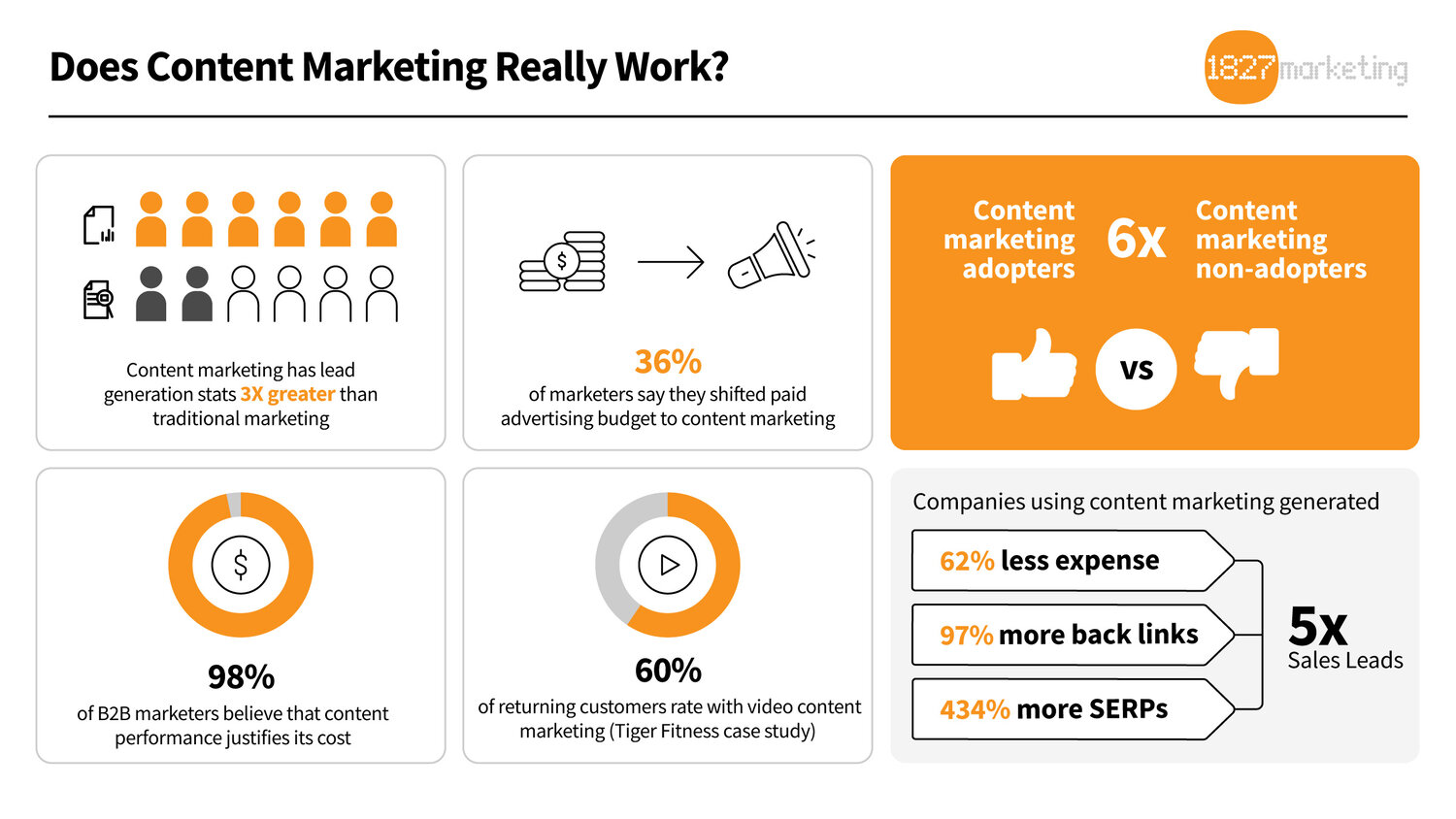
Source: 1827 Marketing
Why is Content Marketing Important for Sales?
Content marketing offers numerous benefits that can significantly impact sales performance. By implementing a well-planned content strategy, you can achieve the following advantages:
- Increased brand awareness: Consistently producing high-quality content helps your business get noticed by potential customers. Sharing informative and engaging articles on social media platforms or guest posting on popular websites increases your online visibility.
- Better customer engagement: Providing valuable information to your target audience fosters trust and loyalty, which in turn encourages them to engage with your brand. This could be through comments, shares, or even direct inquiries about products or services.
- Educating prospects: Informative content such as blog posts, whitepapers, and case studies help educate potential customers about the features and benefits of your offerings.
- Inbound lead generation: Well-optimized content attracts organic traffic from search engines like Google. By including strategically placed calls-to-action (CTAs) in your content, you can turn visitors into leads who are more likely to become paying customers later on.
To reap these benefits effectively, it’s crucial to develop a comprehensive content marketing plan tailored specifically for driving sales and increasing your bottom line.
What is the Difference between Sales and Marketing Content?
The difference between sales and marketing content has to do with how they’re used.
While both types of content aim to ultimately drive revenue for a company, they serve distinct purposes and require unique strategies to be effective.
Sales content focuses on driving conversions by persuading potential customers to make a purchase. Product details, cost data, customer stories, and other materials that demonstrate the worth of a product or service are usually included in sales content to encourage customers to take action.
On the other hand, marketing content aims at building relationships with customers through engaging storytelling that raises brand awareness and establishes trust. Examples include blog posts about industry trends or tips for using your products more effectively.
Let me show you their main differences:
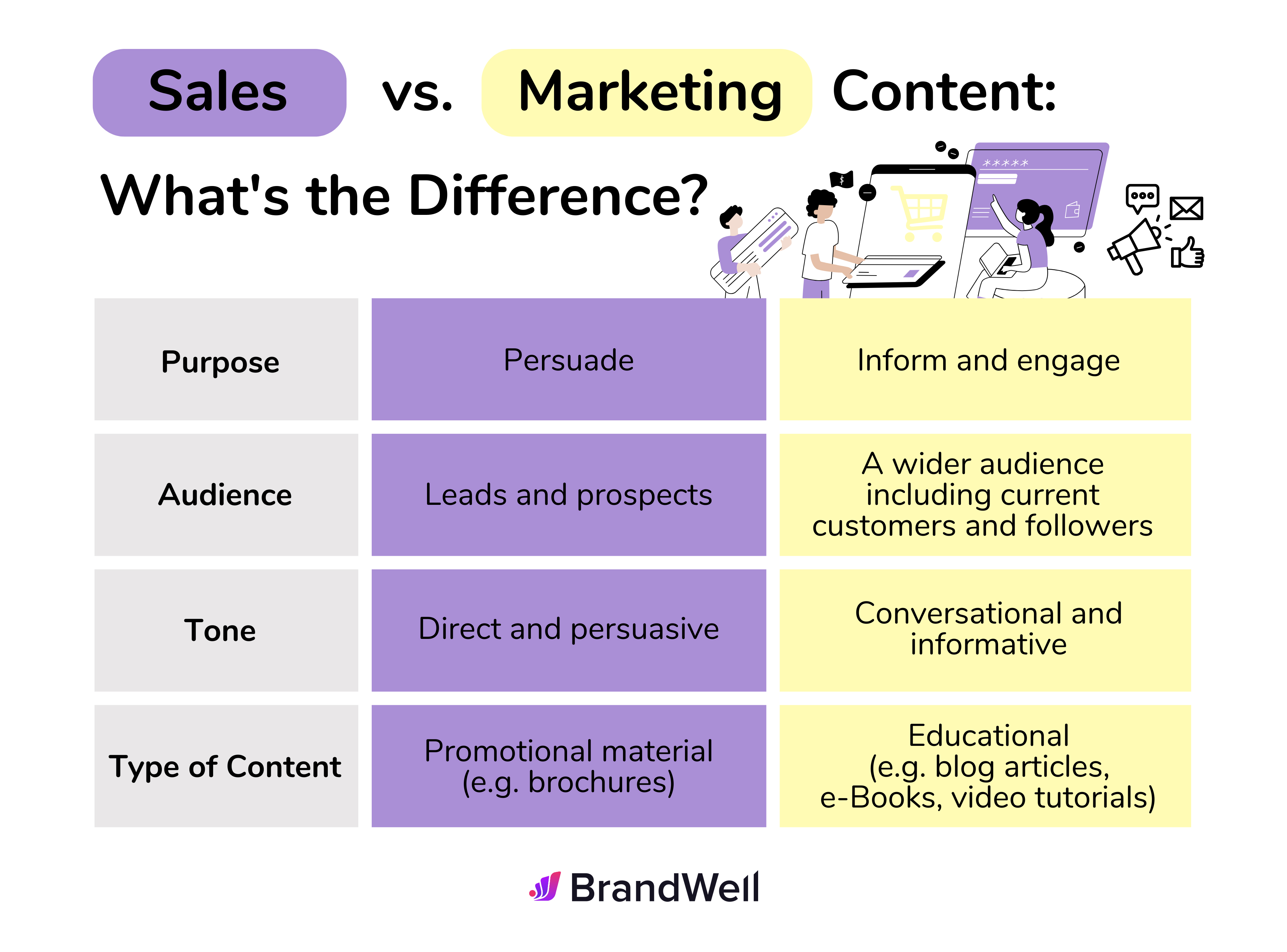
To maximize success in reaching your business goals, you should develop both sales-focused and marketing-oriented content as part of an integrated strategy. Next, let’s dive deeper into the goals and strategies behind each type of content.
The Objectives of Sales Content
What is the difference between sales and marketing content in terms of goals/objectives?
Sales content is designed to drive conversions and close deals by persuading potential customers to make a purchase. It focuses on displaying the advantages and characteristics of an item or service, tackling customer issues, and giving precise calls-to-action (CTAs) that lead prospects through the buying cycle.
- Highlighting benefits: Sales content emphasizes how a product or service can solve specific problems for customers. By demonstrating value, it aims to convince prospects that they need what you’re offering. For example, an article about selling benefits versus features explains why focusing on benefits is more effective in sales.
- Addressing pain points: Effective sales content identifies common challenges your target audience faces and demonstrates how your solution can alleviate those issues. This approach helps build trust with potential buyers as they recognize that you understand their needs and are willing to help.
- Incorporating CTAs: Calls-to-action are crucial elements in sales content because they prompt readers to take action – whether it’s signing up for a newsletter, downloading an eBook, or making a purchase. A well-crafted CTA should be compelling and easy to find within the text. Check out these examples from HubSpot.
Sales copywriting aims to persuade prospective buyers to purchase an item or service. On the other hand, marketing content is designed to create awareness and build relationships with an audience that may not be ready for a sales pitch yet.
Let’s take a look at what objectives are behind marketing content.
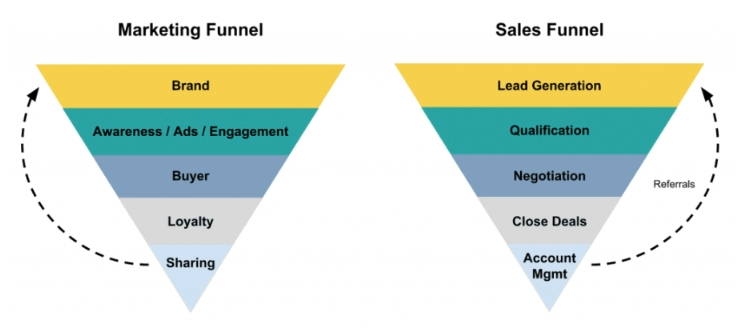
The difference between a marketing funnel and a sales funnel
The Objectives of Marketing Content
Marketing content serves a different purpose than sales content. Its primary goal is to build relationships with customers and create brand awareness. By providing valuable information, engaging stories, and relevant insights, marketing content helps businesses establish trust with their target audience.
To achieve these objectives, marketing content often focuses on the following areas:
- Educating potential customers: This includes sharing industry knowledge or offering solutions to common problems that your audience faces.
- Increasing brand visibility: Through social media posts, blog articles, and other digital channels, your company can reach more people and become recognized as a thought leader in your field.
- Building customer loyalty: By consistently delivering high-quality content that resonates with readers’ needs and interests, you can foster long-term connections with your audience members who are more likely to convert into paying customers later on.
- Generating leads for future sales efforts: While not directly focused on closing deals like sales content does, marketing content can still encourage prospects to provide contact information or sign up for newsletters – allowing companies to nurture those leads over time until they’re ready to make a purchase decision.
Marketing content works to form a basis for future sales — developing an appealing brand persona, establishing trust with prospective clients, and providing useful info that can help them make informed choices when they’re ready to buy.
The Strategy Behind Effective Sales Content
What is the difference between sales and marketing content in terms of strategies?
In general, both sales and marketing content need solid plans behind them if you want to get results.
Creating effective sales content requires a strategic approach that resonates with customers and drives them to take action. The following tactics are essential for crafting compelling sales materials:
- Targeted messaging: Tailor your message to address the specific needs, pain points, and desires of your target audience. This can be achieved by conducting a thorough market analysis.
- Persuasive writing techniques: Use persuasive writing techniques such as the AIDA model (Attention, Interest, Desire, Action) or the PAS formula (Problem-Agitate-Solve) to create an emotional connection with readers.
- Credibility-building elements: Incorporate testimonials, case studies, and statistics into your content to establish trustworthiness and demonstrate the effectiveness of your product or service.
- Actionable calls-to-action (CTAs): Encourage prospects to take immediate action by including clear CTAs throughout your content. These should be direct, impactful statements like “Schedule a demo” or “Download our free guide.”
- A/B testing and optimization: Continuously test different versions of headlines, body copy, images, etc., to identify which elements yield higher conversion rates.
Incorporating these strategies will ensure that your sales content is engaging and persuasive enough for potential customers to not only read but also act upon it.
Now let’s look at marketing content strategies and how they differ from sales tactics.

HubSpot demonstrates how humor can make sales content more effective
The Strategy Behind ROI-Worthy Marketing Content
To connect with audiences, you need to craft compelling and engaging personalized content. Some of the most successful approaches include:
- Storytelling: Sharing relatable stories can help humanize your brand and create an emotional connection with your audience. This approach helps make complex topics more accessible and memorable.
- Educational content: Providing valuable information through blog posts, whitepapers, or webinars can establish your brand as a thought leader in its industry. By offering solutions to common problems faced by customers, you build trust and credibility with potential clients.
- User-generated content (UGC): Encouraging users to share their experiences using your products or services on social media platforms not only increases engagement but also provides authentic testimonials for other potential customers to see.
- Social media engagement: Participating in social media allows you to interact directly with your target audience while raising brand awareness effectively. Respond promptly and genuinely engage in conversations to foster deeper relationships with your fan base
Best marketing content types to grow your business
Mapping Content to Each Buyer’s Journey
Creating content for each stage of the buyer’s journey is essential for successful content marketing. This involves tailoring content for the top of the funnel (awareness), the middle of the funnel (consideration), and the bottom of the funnel (decision).
Awareness Stage
At this stage, your goal is to attract traffic by addressing the pain points of potential customers. Examples of top-of-funnel content are blog articles, social media posts, e-books, and white papers.
Consideration Stage
This phase focuses on nurturing leads with more in-depth information about your products or services. You can create product comparisons, case studies, webinars, and email marketing campaigns tailored to their needs.
Decision-Making Stage
To convert leads into paying customers at this final stage of the sales funnel, offer persuasive materials such as success stories from satisfied clients or exclusive discounts for first-time buyers.
Mapping content is an effective way to lead prospects through the funnel until they are ready to buy.
By building trust through expert positioning, you can provide more in-depth materials about your products or services which will lead potential buyers closer to making a purchase.

Screenshot from Ahrefs
Building Trust Through Expert Positioning
Content marketing can help position your brand as the go-to expert in your industry. Engaging formats like e-books, white papers, or checklists that solve customer problems can solidify this expert status among consumers.
Informative Blog Posts Addressing Common Issues
Publishing high-quality content on your blog can help address common issues faced by potential customers and showcase your knowledge in the field. For example, create articles on product comparisons, success stories, and evergreen content to attract traffic to your website while providing valuable information for prospective clients.
Educational Resources Showcasing Product/Service Benefits
- Email marketing: Offering a series of email courses can educate subscribers about the benefits of using your products/services while nurturing leads throughout the sales funnel.
- Social media marketing: Sharing tips and tricks related to your niche on social media channels such as Facebook or LinkedIn can improve brand awareness and demonstrate expertise.
- User-generated content (UGC): Encouraging users to create content around their experiences with your offerings not only increases engagement but also provides authentic testimonials that build trust among potential customers.
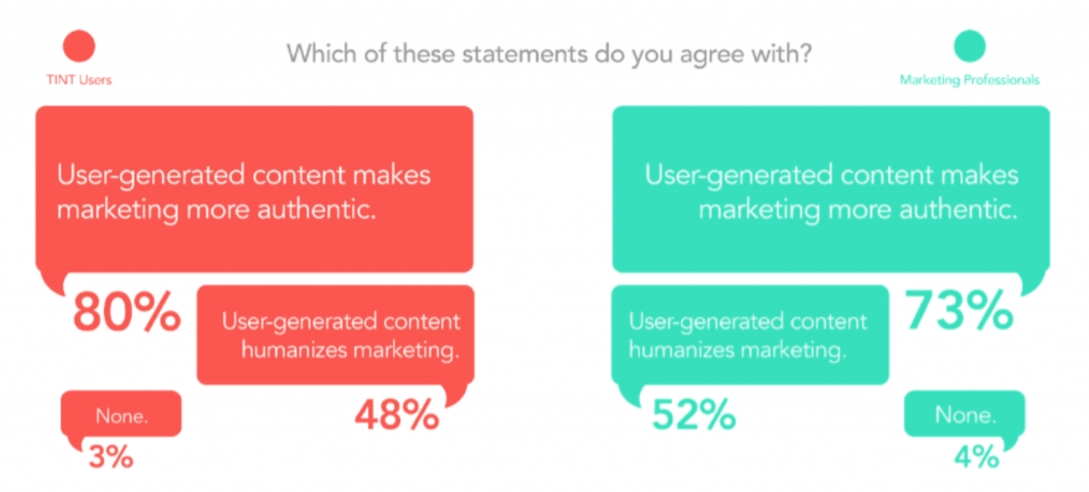
Screenshot from TINT
Increasing Engagement with Audiences Online
To convert leads to sales, it’s crucial to produce valuable material and engage with your audience. If they leave comments on your blog post, respond promptly. If they ask you a question through social media, give them detailed answers. Timely interaction with prospects ultimately leads to increased conversions down the line.
Engaging with your audience can also help you build user-generated content.
- Social media posts: Encourage customers to share their experiences using your products/services on social media channels like Instagram or Facebook.
- Testimonials: Collect testimonials from satisfied clients and showcase them on your website or in email marketing campaigns.
- Case studies: Collaborate with successful clients in creating detailed case studies demonstrating how they achieved success using your product/service.
By engaging with your audience online, you can build relationships that lead to sales.
How do you reach the widest audience possible? By identifying the appropriate channels for distributing your content.
Targeting the Right Channels for Distribution
Identifying your target audiences, when they are online, and where they hang out are critical in determining the right channels for distributing your content.
Research their demographics, interests, and preferred communication methods before deciding where to focus your efforts. This will ensure that your content reaches the right people at the right time to maximize your return on investment (ROI).
Develop a Unique Brand Voice
Brands with a distinct voice are easier to spot in a crowd and can lead to higher conversion rates.
A strong brand voice helps set you apart from competitors and makes it easier for prospects to recognize and connect with your business. Using a consistent tone across all content – from blog posts to emails to social media updates – increases brand awareness while building trust.
How to Balance Sales and Marketing Content
With proper alignment between sales and marketing, companies can increase revenue growth rates by up to 32%.
How do you get these teams to work together?
When creating sales and marketing content, the most important thing is to get the sequence right:
Market when your audience is in the early stages of the buyer journey, and sell only when they’re ready to be sold to.
Marketing messages work well early in the process because they help build trust by addressing customer pain points and establishing value propositions. However, once someone has moved down the funnel and closer to the purchasing stage, then it’s time for more sales-focused messaging.
But how do you know when someone is ready?
Here are a few tips on synchronizing sales and marketing content.
- Create a clear content strategy: To balance both types of content effectively, it’s important to have a clear content strategy that outlines what type of message will resonate best with potential customers at each stage of the buyer journey. This means mapping out all possible touchpoints for your target audience and crafting messages accordingly.
- Maintain consistency across all channels: Whether you’re creating marketing or sales content, it’s essential to tell a consistent story across all channels—from social media posts and blog articles to presentations made by your team members.
- Foster collaboration between your sales and marketing teams: Encourage open communication between these two business functions so they can work together seamlessly throughout every step of the funnel – from attracting leads via marketing efforts to closing deals through direct selling activities.
Balancing sales and marketing isn’t always easy, but with some planning, collaboration, and an informed approach, it is definitely achievable.
Tools That Help Sales and Marketing Succeed
To achieve maximum results from running campaigns, it’s important to align all internal operations properly so there isn’t any confusion regarding goals, targets, and audiences.
This is where CRM software comes in. CRMs allow both sales and marketing teams to work together seamlessly.
The sales team can track leads throughout the entire buyer journey from initial contact through conversion into customers, while the marketing team can use BrandWell to pump out highly targeted content based on specific actions taken by prospects.
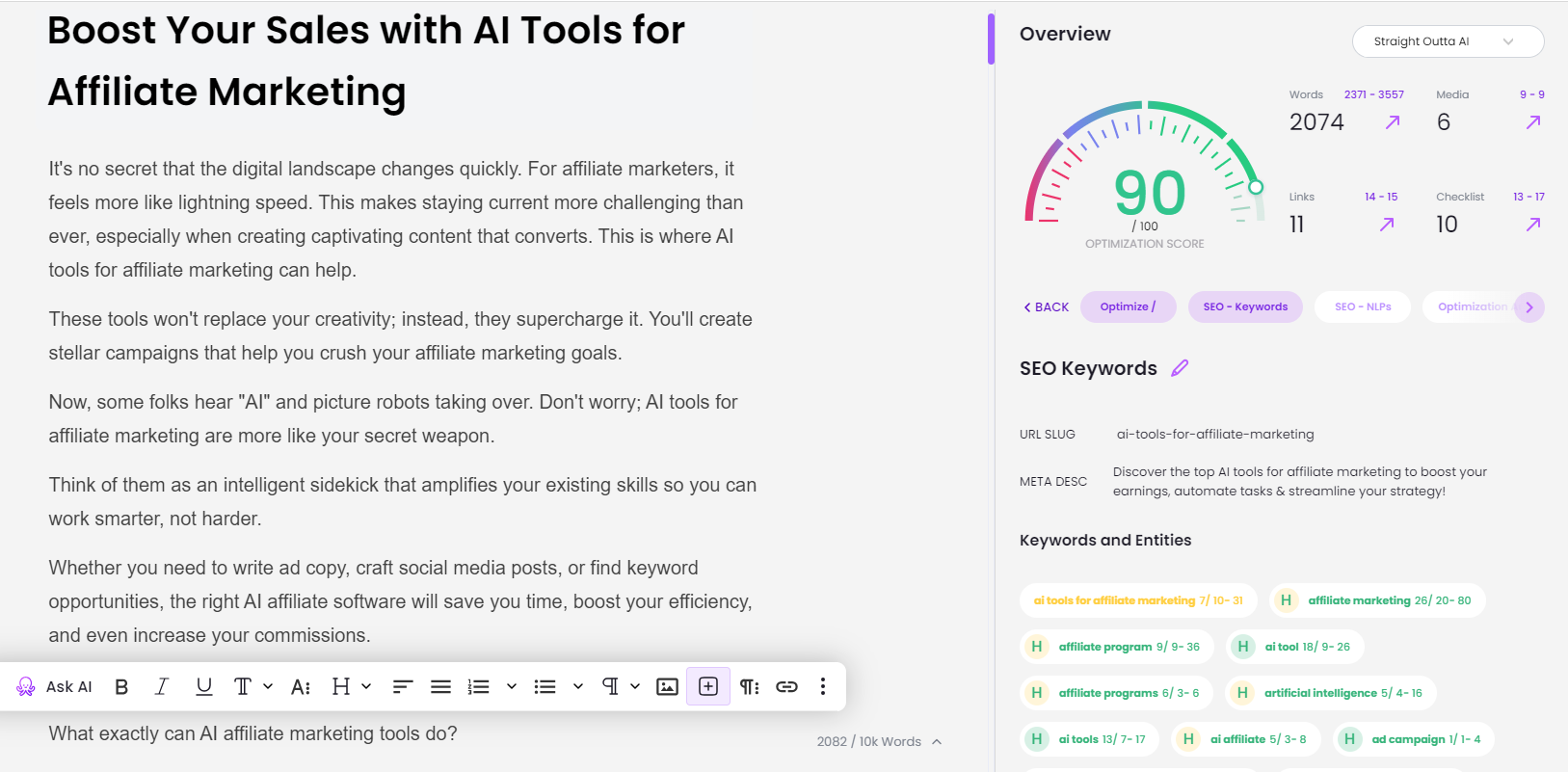
Long-form blog post created by BrandWell
Measuring the Impact of Content on Sales
By analyzing various metrics, you can gain insights into how well your content is performing and make data-driven decisions to improve its effectiveness.
Website Traffic Analysis
An increase in the number of your website visitors means more people are exposed to your offerings. Tools like Google Analytics can help you monitor important metrics in this area such as unique visitors, page views, and average session duration.
Conversion Tracking
To determine if your content is driving sales directly, track conversions from specific pieces of content using conversion tracking tools like Hotjar. This allows you to see which types of content generate leads or purchases most effectively.
Customer Engagement Metrics
There are three important metrics when it comes to customer engagement:
- Social media shares: If your readers like your content, they will share this with their networks across social media platforms. This is a strong indicator that it’s contributing positively towards sales.
- Email open rates: If you’re distributing your content through email campaigns, analyze open rates and click-through rates (CTR) to assess engagement levels with recipients who may become potential customers.
- User comments: Encourage users to leave comments or feedback on blog posts. This can provide valuable insight into their thoughts about the topic or your products while also fostering trust between them and your brand.
By closely monitoring these key performance indicators (KPIs), you can better understand the relationship between content marketing and sales, making it easier to refine strategies for continued success.

Screenshot from Content Marketing Institute
What is Content Scoring?
As your company continues to rely on content marketing to drive sales, you should measure the effectiveness of each piece of content. This is where content scoring comes in.
The Definition: Content scoring is a strategic approach focused on assessing and quantifying the true potential of your content by tracking how individual pieces perform in generating and converting leads. It helps marketers prioritize only those assets that have a higher probability of driving profitable customer action.
The Process: The process involves assigning values or scores to different aspects of your content based on their relevance, engagement potential, and conversion rate. You can then use these scores to determine which pieces are worth investing more time and resources into improving or promoting.
For instance, if you run an email campaign with several different types of emails (e.g., promotional vs informational), you can assign points for open rates, click-throughs, conversions, etc., then compare them against one another using data analysis tools like Google Analytics.
The Benefits: There are many benefits to implementing content scoring.
- Better ROI: By prioritizing high-scoring pieces over low-scoring ones, you’ll see better results from your marketing efforts.
- Informed decision-making: With data-driven insights at hand about what works best for your audience(s), you can make informed decisions about future campaigns.
- Easier optimization: When analyzing why certain pieces score higher than others, it becomes easier to optimize underperforming areas such as headlines or calls-to-action.
Overall, content marketing isn’t just important — it’s critical. And by incorporating methods like content scoring into your digital marketing strategy, you can ensure that your efforts are focused on creating high-quality content that encourages repeat sales and builds a positive brand reputation.
Content Is Your New Sales Team
Gone are the days when a salesperson was the primary source of information for buyers. Today’s buyer is more likely to be a millennial and a digital native who expects the sales process to be frictionless.
This means that traditional sales tactics such as cold calling and door-to-door selling are becoming less effective. Instead, you need to focus on creating high-quality content that speaks directly to your target audience.
With content marketing, you can create a sales process that is more customer-centric. Instead of pushing products or services onto potential customers, use content to guide them through the buyer’s journey at their own pace. This means providing valuable information that speaks directly to their needs.
If you’re ready to take advantage of this powerful new way to sell, then start developing your content marketing strategy today!
Why is Content Marketing Important for Sales? 3 Words: Engage, Nurture, Convert
Why is content marketing important for sales? So many reasons.
Content marketing is a crucial aspect of any marketing strategy. It involves creating and sharing high-quality content assets that are designed to educate, inform, and engage potential customers. Unlike traditional marketing which focuses on promoting products or services directly, content marketing aims to build relationships with customers by providing them with valuable information that they can use to make informed decisions.
One of the primary benefits of content marketing is that it helps you establish your business as an industry expert. By creating and sharing content that is relevant to your target audience, you can demonstrate your knowledge and expertise in your field. This, in turn, helps to build trust with potential customers, making them more likely to choose your business over competitors.
Another benefit of content marketing is that it can help increase brand awareness. By creating content that is optimized for search engines and social media, you can reach a wider audience and attract more potential customers to your website. This can lead to increased lead generation and higher revenue.
Ultimately, the key to success with content marketing is to create high-quality content that is tailored to your target audience. By understanding the needs and interests of your potential customers, you can create content that resonates with them and provides them with real value. By doing so, you can build relationships with your audience and drive sales over time.

UNLOCK YOUR POTENTIAL
Long Headline that highlights Value Proposition of Lead Magnet
Grab a front row seat to our video masterclasses, interviews, case studies, tutorials, and guides.


